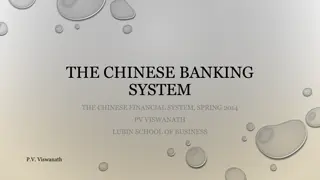Evolution of State Banking in 19th Century America
American economic development in the 19th century was driven by the abundance of resources and the necessity for capital-intensive projects. The expansion of the economy, adoption of technology, and integration into a national economy required a robust financial system with financial intermediaries playing a crucial role in efficient resource allocation. Fractional-reserve banking was a notable practice during this period.
Uploaded on Oct 05, 2024 | 0 Views
Download Presentation

Please find below an Image/Link to download the presentation.
The content on the website is provided AS IS for your information and personal use only. It may not be sold, licensed, or shared on other websites without obtaining consent from the author.If you encounter any issues during the download, it is possible that the publisher has removed the file from their server.
You are allowed to download the files provided on this website for personal or commercial use, subject to the condition that they are used lawfully. All files are the property of their respective owners.
The content on the website is provided AS IS for your information and personal use only. It may not be sold, licensed, or shared on other websites without obtaining consent from the author.
E N D
Presentation Transcript
Topic 1. Part 3A. The Growth of State Banking to 1860
American Economic Development in the 19th Century was driven by the fact that the US was Long on Resources but Short on Population. This meant that Economic Development was Capital Intensive. Hence, the need for robust financial markets to finance entrepreneurs, machines, and complex construction projects.
The U.S. economy in 19th Century was unique because: 1) expansion of the economy over space; 2) invention & adoption of capital-intensive technology in transportation, manufacturing, and construction; 3) And by the 1860s (and especially by the 1890s), an integration into one national economy.
This required a ROBUST financial system capable of raising the large sums required to develop all the economic infrastructure required for a rapidly growing population and increasingly sophisticated division of labor.
To have a Robust Financial System You Must have Financial Intermediaries Definition -- FINANCIAL INTERMEDIARY: An entity that acts as the middleman between two parties in a financial transaction. While a commercial bank is a typical financial intermediary, this category also includes other financial institutions such as investment banks, insurance companies, broker-dealers, mutual funds and pension funds.
Financial Intermediaries: Purpose is to "...allocate financial resources efficiently by gathering them from savers and distributing them to the most qualified investors." ... "...banks differ from other intermediaries in that their liabilities also commonly serve as money ... [and] "...under a fractional reserve system of banking, banks are the only private institutions which can create money... (Sylla, 1971, Explorations in Economic History)
Wikipedia (edited): Fractional-reserve banking is the practice whereby a bank retains reserves in an amount equal to only a portion of the amount of its customers' deposits to satisfy potential demands for withdrawals. Reserves are held at the bank as currency, or as deposits in the bank's accounts at the central bank.The remainder of customer-deposited funds are used to fund investments or loans that the bank makes to other customers. THIS HAS THE EFFECT OF INCREASING THE MONEY SUPPLY!
Because Banks Can Create Money Government Must Have a Regulatory Role! To mitigate the risks of bank or systemic crises, the governments of most countries regulate and oversee commercial banks, provide deposit insurance and act as lender of last resort to commercial banks.The central bank regulates bank credit creation, imposing reserve requirements and other capital adequacy ratios. This limits the amount of money creation that occurs in the commercial banking system, and helps ensure that banks have enough funds to meet the demand for withdrawals.
Rousseau & Sylla: What the Americans did, uniquely when they did it, was to charter so many banking corporations that they had to compete with one another rather than enjoy monopolistic privileges.
What was unique about the U.S. economy in 19th Century was: 1) expansion of the economy over space; 2) invention & adoption of capital-intensive technology in transportation, manufacturing, and construction; 3) And by the 1860s (and especially by the 1890s), an integration into one national economy.























